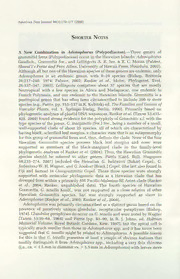Table Of ContentAmerican Fern
Ji
Shorter Notes
—
A New
Adenophorus
Combination (Polypodiaceae). Three genera of
in
Adenophorus
Hawaiian
grammitid ferns (Polypodiaceae) occur in the Islands:
& Moran
Gaudich., Grammitis Sw., and Lellingeria A. R. Sm. R. C. (Palmer,
Hawai'i's Ferns and Fern University of Hawaii Press, Honolulu. 2002).
Allies,
Although but one of the Hawaiian species of these genera are endemic, only
all
Adenophorus an endemic genus, with 8-10 species (Bishop, Brittonia
is
26:217-240. 1974; Palmer, 2002; Ranker al, Molec. Phylogenet. Evol.
et
26:337-347. 2003). Lellingeria comprises about 57 species that are mostly
Neotropical with a few species in Africa and Madagascar, one endemic to
French Polynesia, and one endemic to the Hawaiian Islands. Grammitis a
is
more
pantropical genus that has often been circumscribed to include 200 or
species Parris, pp. 153-157 in K. Kubitzki ed, The Families and Genera of
(e.g.,
Vascular Plants, vol. Springer-Verlag, Berlin. 1990). Primarily based on
1.
DNA
Ranker (Taxon 53:415-
phylogenetic analyses of plastid sequences, et
al.
428. 2004) found strong evidence for the polyphyly of Grammitis with the
s.l.
member
type species of the genus, G. marginella (Sw.) Sw., being a of a small,
which by
well-supported clade of about 25 species, of are characterized
all
having black, sclerified leaf margins, a character state that an autapomorphy
is
None
for this group of grammitid ferns and, thus, defines the clade. of the four
Hawaiian Grammitis species possess black margins and none were
leaf
members
supported as of the black-margined clade in the family-level
phylogenetic analyses of Ranker Thus, the Hawaiian Grammitis
et al. (2004).
species should be referred to other genera. Parris (Gard. Bull. Singapore
58:233-274. 2007) included the Hawaiian G. baldwinii (Baker) Copel., G.
W.
forbesiana H. Wagner, and G. hookeri (Brack.) Copel. (the last also found in
Fiji and Samoa) in Oreogrammitis Copel. Those three species were strongly
supported with molecular phylogenetic data as a Hawaiian clade that has
W
diverged from within primarily S Pacific-Malesian-SE Asian clade (Ranker
a
et 2004; Ranker, unpublished The fourth species of Hawaiian
al., data).
Grammitis, was
G. tenella Kaulf., not supported as a close relative of other
Hawaiian Grammitis species, but was strongly supported as sister to
Adenophorus
(Ranker Ranker
2003;
et et 2004).
al., al.,
Adenophorus was
primarily circumscribed genus based on the
as a distinct
presence of putatively unique glandular, receptacular paraphyses (Bishop,
1974). Glandular paraphyses do occur on and were noted by Wagner
G. tenella
(Taxon 13:56-64. 1964) and Parris 81-90, in Johns, ed, Holttum
(pp. R.
J.
Memorial Volume,
Royal Botanic Gardens, Kew.
1997), but the apical cell
is
much
typically smaller than those in Adenophorus spp. and has never been
it
A
suggested that G. tenella might be related to Adenophorus. possible reason
for this is that G. tenella possesses at least a couple of obvious features that
from Adenophorus
readily distinguish spp., including a very thin rhizome
it
mm mm
< >
ca. 1.5 in diameter vs. 1.5 in Adenophorus) with leaves more
(i.e.,
separated than found most Adenophorus, and
is in species of mostly glabrous
leaf lamina (vs. lamina with varying densities of glandular
hairs in
Adenophorus). Molecular
phylogenetic evidence, however, provides
robust
support for a sister-taxon relationship between and Adeno-
G. tenella the
phorus
clade (Ranker Ranker
et al., 2003; et al, 2004). Phylogenetic analyses of
sequence
variation for the plastid genes rbcL and supported
atpfi this sister-
98%
taxon relationship with parsimony
bootstrap support,
1.0 posterior
probability Bayesian support, and Bremer support The
of 7 steps. well-
supported group + Adenophorus
sister to the G. tenella clade includes the
monophyletic
black-margined Grammitis
spp. as the monophyletic
sister to
genus Cochlidium Kaulf. Neither of the latter two groups possess glandular,
receptacular paraphyses. Thus, even though glandular paraphyses of varying
morphology
occur grammitid
in a diversity of taxa, their presence in G. tenella
and Adenophorus
synapomorphy combined
spp. serves as a for that clade.
Because
of this shared feature of glandular, receptacular paraphyses and
in
light of the highly robust molecular phylogenetic data, propose the following
I
combination Adenophorus.
in
nov-
tenellus Ranker, comb, Grammitis
(Kaulf.) tenella Kaulf.,
TYPE.—OWahu
Enum.
1824. insularum Sandwich., Chamisso
Filic. 84.
s.n.
(holotype, LE; photo of holotype BISH!).
at
HAWAIIAN
Specimens examined BISH: ISLANDS:
at Kaua'i: 1895, A. A.
Heller 2215; 1917, C. N. Forbes 1705K; 1969, Henrickson 4001; 1955, B. C.
/.
Stone 796; 1960, B. C. Stone 3343; 1983, W. Takeuchi Alakai_192. O'ahu:
1923, D. Topping 2647; 1984, W. Takeuchi Koolau_30; 1930, H. John
L.
St.
Banker
10615; 1932, H. John 11688; 1932, H. John 12220; 1990, A.
St. St. T. et
Chock
al. 1098; 1933, F. B. Fosberg 9429; 1951, A. K. 206. Moloka'i: 1948, H.
Munro
St. John 23419; 1987, D. H. Lorence 5469. Lana'i: 1915, G. C. 470; 1935,
&
Hobdy
F. B. Fosberg 12487; 1963, O. Degener 30152. Maui: 1984, B. 1990;
I.
&
Mizuno
1976, P. K. Higashino G. 3098. Hawai'i: 1954, H. St. John 25395;
1990, T. A. Banker 1117; 1989, T. A. Banker 996; 1980, F. B. Fosberg 60552;
Wood
4723.—
Department
1995, K. B. -Tom A. Ranker, of Botany, University of
Hawai'i Manoa, 3190 Maile Way, John Honolulu, HI 96822.
101,
at St.
Two
Range Expansion of Tropical to Subtropical Ferns, Ladder Brake {Pteris
vittata and Lace Fern {Microlepia strigosa (Thunb. ex Murray) K. PresL),
L.)
in the Urban Osaka Bay Area, Western Japan—Murakami et (Amer. Fern
al.
J.
northward range
97(4):12-24. 2007) reported the clear local shift of the
greenhouse weed Thelypteris dentata (Forssk.) St. John as an example of range
They
expansion of a tropical species. estimated this species' dispersal rate as
km km
approximately 60 to 100 over 20 years, or 3 to 5 per year. This
may
two
remarkable northward expansion be but other
rare, tropical
to

